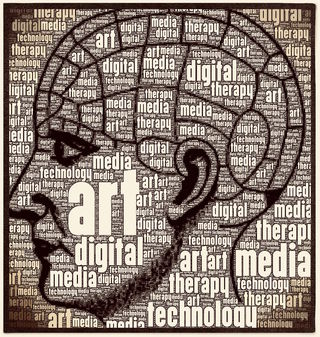Media
Art Therapy and Digital Technology: Digital Art Therapy
Here is a relative newcomer to art therapy approaches and practice.
Posted December 31, 2017

I am excited to be starting the actual production process for a new book for 2018: The Art Therapy and Digital Technology Sourcebook. It is a dynamic collection of international contributions from leading practitioners who embrace digital technology in their arts-based approaches to therapy, education and research. Most of all, I am pleased to be able to bring this work to print as sort of a “sequel” to Art Therapy and Computer Technology (Malchiodi, 2000), the first book to address electronic and emerging digital technology in the practice of art therapy and the precursors of social networking and social media.
Digital art therapy is a relative newcomer to art therapy methods and materials that can be defined as “all forms of technology-based media, including digital collage, illustrations, films, and photography that are used by therapists to assist clients in creating art as part of the process of therapy” (Malchiodi, 2011, p. 33). It involves any activities that use computer keyboards and screens or other technological devices for image-making within the context of treatment. Equipment used to generate, modify or manipulate images and electronic methods such as electronic processing (computers or tablet devices), photocopying, filmmaking, videotaping, and photography in various iterations from single reflex devices to digital cameras and smart phones are also part of spectrum of digital art therapy methodologies. These technologies include, but are not limited to these currently popular forms: apps and various forms of image-creation and film editing software; animation; gaming, virtual reality (VR) and participatory environments; tablet technology; light painting; artificial intelligence; and digital storytelling as well as other techno-media.
The availability of digital technology and media has exponentially enlarged capabilities for creative expression, communication and networking; as these advancements rapidly continue to emerge, there is also an increased curiosity and discussion among art therapist about the impact and applications of digital technology on practice. This is largely due to several factors. There is now a wide availability of digital equipment and software today for image creation and communication not only through a computer screen, but also via personal cellular phones and other compact devices. One can create imagery by using an endless variety of painting and drawing apps, or simply manipulate images through various collage software, apps or online programs. For example, it is remarkably easy now to transform pre-existing images through 21st advances through user-friendly photo enhancement software and apps (see Word Photo app image in this post) as well as Internet programs that allow user to “clip” images for use and manipulation in art expression. There are also easily accessible online photo and film editing software and increasingly accessible devices such as computer webcams, pocket-sized film cameras and smartphones that can both take photographs and create film footage. The currently ubiquitous YouTube has generated video possibilities unimaginable only a decade ago. All of these developments have raised interest among art therapists and others who apply art-based methods in their work with individuals of all ages.
The art world has also embraced digital technology as a significant part of image-making. Contemporary artists are incorporating VR, robotics, artificial intelligence and various digital image manipulation methods in their work, integrating technologies that are currently having a major influence on society and culture. These rapidly emerging art forms force not only artists to broaden the question of “what are art materials,” but also impact how art therapists and those who apply art-based media to meet therapeutic goals and to enhance self-expression. In brief, art therapy’s “palette” has expanded from what may be defined as more “low tech” materials to digital forms of self-expression and communication.
Also, it is now difficult for any practitioner to ignore that increasing numbers of art therapy clients are influenced and involved on a daily basis with digital media and networking. In other words, it is impossible to compartmentalize just how digital media and networking contribute to psychosocial experiences and the role of technology in individuals’ world views. This is particularly true in working with young clients who make up a group known as “digital natives” (individuals born after 1980 who grew up in the digital age in communities and cultures with access to technology) now demands that those who provide intervention to children understand the possibilities, challenges and limitations of digital technology. This is the generation who are “native speakers” of the digital language of computers, video games, the Internet and eventually social media. In contrast, art therapists (like myself) may be part of the slowly decreasing group known as digital immigrants who were born before 1980 and became familiar with digital communication and devices as adults. The emergence of digital natives not only impacts direct art therapy services, it also continues to affect the delivery of art therapy education to incoming students who are savvy consumers of technology and social networking platforms.
This is a brief preview of what I hope is an informative resource that will be available in mid-2018. Until then, here are few websites where you can learn more about this evolving domain called digital art therapy:
Art Therapy, Digital Technology and Social Media at www.digitalarttherapyinfo.com.
Art Therapy, Digital Technology and Social Media on Facebook at https://www.facebook.com/digitalarttherapysocialmedia/
New Media Art Therapy on Facebook at https://www.facebook.com/groups/303288843472155/
Virtual Reality Art Therapy at https://www.virtualrealityarttherapy.com/.
References
Malchiodi, C. A. (2000). Art Therapy and Computer Technology. London: Jessica Kingsley Publishers.
Malchiodi, C. A. (2011). Materials and media in art therapy. In C. Malchiodi (Ed.) Handbook of Art Therapy (2nd ed.). New York: Guilford Publications.
Malchiodi, C. A. (ed.). (in press). The Art Therapy and Digital Technology Sourcebook. London: Jessica Kingsley Publishers.


